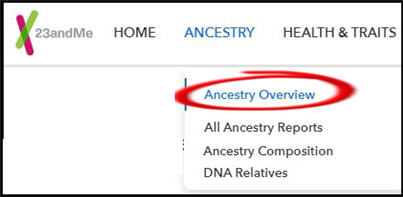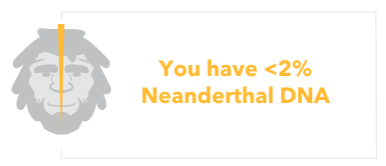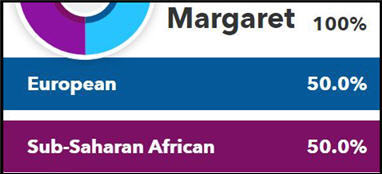23andMe are well-known for giving customers an estimate of their Neanderthal DNA.
This article explains the background behind these estimates. We’ll also show you how to interpret each aspect of your Neanderthal report.
How To Find Your Neanderthal Reports On 23andMe
23andMe change where they put things from time to time.
I’m pretty sure that the link to the Neanderthal reports was on the Home Page at some point. But it’s not immediately apparent anymore.
If you can’t find it, here is one way to access your Neanderthal reports (the link is in several places).Open the “Ancestry Overview” page from the Ancestry drop-down menu.

Scroll down below the DNA Relatives List section, where you will find the Neanderthal Ancestry section.

Click “View your report” to see your Neanderthal data.
Your Neanderthal reports have a lot of data across multiple sections.
Before I run through the different sections, I think it’s worth explaining the theory behind what you’re seeing.
How Do Humans Have Neanderthal DNA?
Unlike ourselves, the Neanderthals first evolved in Europe and Asia. In contrast, we Homo Sapiens first appeared in Africa.
When our human ancestors migrated into Europe and Asia, they co-existed for tens of thousands of years with Neanderthals.
The question of whether Homo Sapiens and Homo Neanderthalensis interacted in any way was debated through the 20th century and early 21st century.
2010 sequencing of the Neanderthal genome
In 2010, geneticists sequenced the genome of Neanderthal genomes and compared the DNA to modern humans.
A small but significant percentage of markers (DNA positions) in some modern humans were determined to be inherited from Neanderthal ancestors.
This confirmed that there was interbreeding between the two species before the Neanderthals disappeared.
How much Neanderthal DNA do we have?
The percentage of Neanderthal DNA amongst modern humans varies across the world.
Outside of Africa, it varies from about one to four percent.
In some parts of Africa, no Neanderthal variants are present.
A Brief History Of 23andMe And Neanderthal DNA
23andMe was the first major commercial DNA testing company to take an interest in the Neanderthal DNA components of their customers.
They approached the scientists involved in the 2010 genome study for a list of the DNA markers identified as of Neanderthal origin.
Neanderthal Variants
Most human DNA is identical, so your DNA test focuses on positions on the genome that are known to vary across our species. Not surprisingly, these may be called “variants”.
23andMe tests about 640K positions, known as SNPs (and pronounced “snips”).
They determined that several thousand of these positions corresponded to the Neanderthal variants.
First Neanderthal reports
In 2011, 23andMe rolled out their Neanderthal report.
This early report counted the number of Neanderthal variants in your DNA results. Customers were intrigued to see their “percentage” of Neanderthal DNA.
Traits
23andMe took their analysis of your Neanderthal influences a little further.
The company has long conducted surveys on their customers that collect lots of statistics on things like:
- Do you sneeze after eating dark chocolate?
- Do you have a hairy back?
Their scientists took these statistics and correlated them with the Neanderthal variants across their DNA database.
Let’s say that one of the Neanderthal variants may appear on the 12th chromosome pair at positions 20,230,234 – 20,230,208.
Now, let’s say that a high percentage of customers who have this Neanderthal variant also answered Yes to one of those questions.
This means that 23andMe will draw a connection between the trait and the Neanderthal variant.
I hope this makes clear that the methodology is not as ridiculous as the reported results!
Later reports
There have been major developments in research on the Neanderthal genome since 2010.
23andMe also made significant changes to its DNA testing chips.
Customers saw major changes in their Neanderthal reports in 2016. People saw their percentages change quite drastically.
I won’t be surprised if further changes are down the line. It’s important not to take these reports as anything other than estimates based on a current imperfect framework.
How To Read The Neanderthal Report
23andMe reports your Neanderthal DNA in several different ways on the same page.
Don’t be embarrassed if you find this confusing. It confused the heck out of me when I first looked at my report.
Let’s break it down.
You have more than X % of other customers
Their headline figure compares your results to all the other 23andMe customers.
Those of you who have mostly European heritage will see something like this:
You have more Neanderthal DNA than 60% of other customers.
That isn’t too bad for comprehension. But this is what I see:
Hey Margaret! You have more Neanderthal DNA than 3% of other customers.
More than 3%? Maybe Neanderthal brains find that easy to process. It would be a lot clearer to my Human brain if they told me I had less than 97% of their customers.
You have Y% DNA Neanderthal DNA
My report tells me that I have <2% Neanderthal DNA.

If you are of predominantly European heritage, you’ll probably have a slightly higher number here. But it won’t go above 4%.
How many variants?
The other percentages are based on the total number of Neanderthal variants in your DNA results.
The total number of Neanderthal variants is 7,462.
The 23andMe White Paper says that the average number across their customers is about 267.
Some customers have zero variants. While the highest number they’ve seen is 387.
Do you have Neanderthal traits?
Not every 23andMe customer gets Neanderthal traits in the lower section of the report. This happens even to customers who have the higher percentages.
Personally, I have one variant that is associated with the trait of having detached earlobes.
I was amused to see a lady mention on a genealogy forum that her Neanderthal trait for “black hair” was completely accurate.
A friendly poster suggested they read the trait again. It’s a predisposition to having “back hair”. Quite different, particularly where women are concerned.
The other trait that keeps getting mentioned is the predisposition to sneeze after eating dark chocolate. It’s hard to feel a connection to Neanderthal origins through this trait. The detached earlobes make more sense!
Want To Know More About Other Customers?
I’ve trawled through the genealogy forums to see how other 32andMe customers stack up with percentages and variants.
The numbers and descriptions below are reported by customers. It’s interesting to see where you fit in.
If 23andMe tells you that you have more Neanderthal DNA than 50% of other customers, you can see how others rate above or below you.
| Variants | More Than | Ancestry |
| 282 | 58% | |
| 292 | 73% | |
| 301 | 84% | 100% E. Asian |
| 301 | 84% | 32% scandinavian, 30% german |
| 305 | 88% | 100% European |
| 311 | 92% | |
| 324 | 97% | 63% British&Irish |
| 325 | 98% | 99% European |
| 334 | 99% | |
| 348 | 99% | 99% Northwestern European |
| 351 | 99% |
I have a much lower percentage and a paltry 128 variants. But others have even lower than me. Check these out!
| Variants | More than | Ancestry |
| 31 | 0% | |
| 33 | 0% | African American |
| 98 | 2% | |
| 101 | 2% | |
| 128 | 3% | |
| 213 | 5% | Egyptian |
| 229 | 8% | |
| 245 | 14% |
Neanderthal Chromosome Browser
23andMe has several different chromosome browsers.
You will find the Neanderthal chromosome browser when you switch to the “Scientific Details” tab on the Neanderthal report.
This browser displays the position of your Neanderthal variants on your chromosome pairs.
The display is very small – to my eyes. To see it properly, I need to use the Zoom features of my web browser. I find that holding the control and plus key is the easiest way to do this.
Is the Neanderthal browser useful?
There’s not much practical use for this browser.
However, it may be interesting if one side of your heritage is predominantly African and the other is predominantly European.
Your chromosome pairs may look like these:

Notice how the variants only appear on one chromosome within each pair? This is what my Chromosome Browser shows for most of the chromosome pairs.
Below is my ancestry composition on 23andMe. So, I can tell that the Neanderthal variants are coming from one side, and I can guess which side!

Further Exploration Of Your Neanderthal Origins
If you’re fascinated by the Neanderthal report on 23andMe, then you may want to pursue this more deeply.
For example, would you like to see a one-to-one comparison of your DNA to Neanderthal specimens found at archaeological sites across the world?
You can do this for free on the GEDmatch website.
We have step-by-step tutorials that take you through each step (click on the links below).